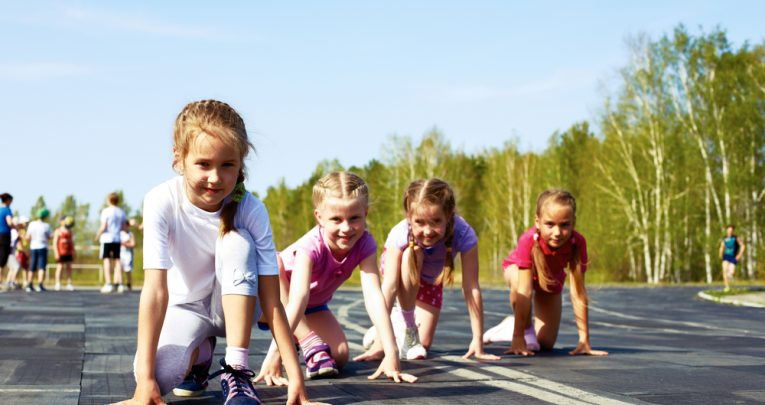Is The DfE’s Approach To Tackling Childhood Obesity On The Right Track?

Does the race to address childhood heath and fitness have a finish line in sight, asks Lloyd Burgess, or are we just running round in circles?…

- by Lloyd Burgess
- Former editor of Teachwire

The sight of angry mothers obstinately smuggling burgers, chips and hot dogs through school gates seems like only yesterday.
Jamie’s School Dinners wasn’t the first time that health and fitness issues in school were brought up, but it felt like a landmark moment, the start of a new iteration in an ongoing saga. But that was 10 years ago. Most primary school children weren’t even born then. While some progress has been made since then, the figures still make for alarming reading. Weight-related issues cost the NHS £47 billion per year; 9.5% of children arrive at primary school obese, yet 19.1% leave obese; and around 80% of those children will go on to become obese adults. If we’ve been addressing these issues for so long, why do they still exist? Are we fighting a losing battle?
Or is it simply that, despite good intentions, we’ve been missing the target all along?
Made to measure
For ukactive’s Geremy Sagoe and Dr Steve Mann, the focus of previous initiatives have either been too narrow, or have missed the mark.
“We don’t really understand the problem because we haven’t had an effective system of measurement,” says Steve. “Look at government initiatives at the moment – we’re tackling childhood obesity with a PE and sport premium, rather than focusing on activity. We’re prioritising competitive sport that may be turning away huge percentages of children who aren’t as physically confident.” “The Child Weight Management Programme, for example, only measures BMI,” adds Geremy. “So unfit children in a normal BMI range are completely ignored, as they’re assumed to be healthy. The former chief medical officer, Sir Liam Donaldson, says this is a greater health risk than being overweight and fit, which is why measurement is so important – to create that solid evidence base that’s currently lacking.” A ukactive report [PDF] released in July last year presented the case for measurement. It stated that many of the arguments focusing on how children’s self-esteem could be harmed through such testing were undermined by the fact they fail to take the views of children into account, being reliant on the assertions of adults alone.
But measuring young people’s fitness doesn’t have to be about singling out children deemed unfit or overweight, and subjecting them to physical and mental torture with tape measures and stopwatches. Geremy is very specific on this point, “Fundamentally, any measurements must be safe, non-invasive, scientifically backed, and most importantly, fun.” It’s a sentiment shared by Fit for Sport CEO, Dean Horridge. “There’s a lot of sensitivity around it, but for me it’s very clear – we should not be testing children’s fitness,” he says. “What we should be doing, though, is measuring it – there’s a big difference between the two. That needs to be made very clear, with guidance on how it should be done. As Dean sees it, the target of getting children involved in sport hasn’t changed for the last 20 years, which is why schools are fighting a losing battle. “It’s time for change,” he insists. “We need to be engaging children with fun activities, which should be a part of the daily routine in schools, and don’t necessarily have to take place within a sporting environment.
‘Parents, schools, the government – we all need to step up to ensure children are getting their recommended 60 minutes a day of physical activity, and that we’re educating them on the benefits doing this.”
Changing lanes
At the moment, however, PE in primary schools only has a minimum of two hours curriculum time, with many schools not even achieving that. So how exactly do you fit the recommended five hours of activity into an already busy timetable? “Schools need to think about what physical activity they can provide around curriculum time, whether it’s extracurricular clubs, links to out-of-school clubs, journeys to and from school or more active, class-based lessons,” suggests Dominic Judge of Youth Sport Trust. “It’s important that teachers consider how they might make their lessons more active, so it’s about engaging activities, about teacher training and about the sustainable use of the PE and sport premium.” One of ukactive’s suggestions is for the PE and sport premium to be renamed as the ‘physical activity and PE premium, in order to promote a far wider variety of activities across the whole school day.
“One thing we want headteachers to consider is a whole-school-day approach to activity, integrating it into everything from walking to school, to a variety of lessons within the curriculum, so a child has the opportunity to be active before, during and after the school day,” says Geremy.
“One of the case studies in our report was Montpellier school in Ealing, which uses ‘kung fu punctuation’ within their English lessons, where the teachers allow children to use physical kung-fu-style hand gestures to show where the punctuation would go within a sentence. A small thing like that shows children that activity is fun.”
Lagging behind
But what of those of you at the chalkface? If health, fitness and physical activity are such huge issues, why are many teachers receiving minimal training and then being expected to engage inactive kids via two hours a week of substandard PE?
“The government has given a significant commitment of £150m a year to this and, rightly, will quickly move from assessing whether it is merely spent, to assessing whether it is spent wisely and sustainably,” says Dominic Judge. “The best schools are using coaches to upskill teachers for the long term; they don’t take the place of staff while they get extra PPA time.
‘The schools that really ‘get it’ are the ones where the mindset is that you support PE and physical activity as part of your overall school improvement plan.” One such school is Lowther Primary School in Barnes. Teachers Naomi Hallam and Michelle Barker say that their head’s enthusiasm for sport and PE sets the tone for the rest of the school. “There’s a commitment that everyone teaches PE, and teaches it to the highest possible standard,” says Naomi. “We’re a very sporty staff, which helps. But in schools where there are teachers who aren’t keen on PE it’s not usually taught as often, or to the same standard. My initial teacher training only had about four to six hours of PE training. It was fine for me, as I’d done a sports degree, but there were others on the course who left without a clue. I’ve even got a friend who says, ‘I just don’t teach PE.’” “It’s a commitment from the teachers and the headteacher, I think, that makes that possible,’ adds Michelle. ‘Our clubs are free to attend, and run by teachers at the end of the day.” Lowther’s range of clubs isn’t exactly your bog-standard school offering either. As well as the usual team sports and gymnastics you’ll find things like roller-skating and circus skills.
“Something else we’ve talked about is introducing 10-minute bursts of activity throughout the day,” says Michelle. “It’s a way to get children more active, but as a whole class, so individuals don’t feel singled out. Everyone’s participating in an informal, non-competitive way.”
The final straight
At Castle Hill Primary School in Chessington, teacher Rebecca Morley also believes that subject knowledge is a huge hurdle for some. “Knowing how to break something down is crucial,” she says. “With tennis, for example, what does that actually look like stage by stage? What does a child need to be able to do?
‘I teach Year 3 and we play hand tennis. At that age, if you give children a racquet that’s just something else they’ve got to try to control, as well as their body. Make it simple for them, and structure lessons.
‘We’re in week five at the moment and we still haven’t got the nets out yet! We’ve been practising hand-eye coordination and moving in different directions. Teachers do it all the time with subjects like literacy, and it’s really the same with PE – start with something simple and build up.”
But what if you’re one of those without a sports degree, who only received a few hours’ training, and whose school isn’t pushing an active agenda? Organisations Fit for Sport, ukactive, Youth Sport Trust and many others are there to help you.
For example, on a hot day in July 2015, 41 teachers gathered together in their sports gear at Twickenham Stadium ready for the day’s lessons at the Virgin Active Summer Camp. It was the second day of the camp,and aside from the high demand for hangover-alleviating bacon sarnies, everyone was there to promote a healthy, active lifestyle for kids, through fun, active and inclusive PE lessons. According to senior lecturer Dr Victoria Goodyear, the big idea behind it all is the Play Makers programme, inspired by the cooperative learning model. “What they’re doing today is an exercise called ‘jigsaw’,” she explains. “And the key idea behind cooperative learning is that students are dependent on each other, rather than the teacher.
‘The information comes from cards and resources, and children have to cooperate and interact in order to learn. They’re all dependent on each other, like a jigsaw puzzle. Everyone is involved. You work in mixed groups too, rather than ability groups. It’s about giving them complete ownership and complete decision-making, but in a structured way. The summer camp is the initial start of everything. The goal of the day is for teachers to become confident in teaching and planning.” The series of steps needed to get children’s fitness and activity levels back on track might seem a long one, but at least it finally appears as though we know in which event we’re competing.
“The message I’ve picked up is that we want children to be active and participate in sport and activities forever,” says Naomi Hallam. “It’s not just about ‘in school’; it’s a lifelong commitment to saying ‘I’m going to lead a healthy lifestyle’. As primary teachers, we’re accountable for promoting that and for ensuring children’s first taster of sport and activity is a good one, so that they’ll want to come back for more.”
Tale of the tape
See how schools are measuring up with these interesting facts and figures from two recent research projects…
Generation Inactive by ukac • An active child is 15% more likely to go on to higher education and so earn 7 to 8% more money throughout his or her lifetime
• 91% of primary schools recorded or tracked the amount of time children spend in PE lessons, but only 1% formally measured children’s physical literacy or motor proficiency
• Worryingly, only 43% recorded or tracked the amount of time children spent being physically active in PE lessons (rather than getting changed, etc.)
Class of 2035 by Youth Sport Trust • 40% of those who say they don’t like PE in secondary school say this is because they don’t like the types of sport played; the figure is 5% higher amongst girls than boys
• Those who do 60 minutes of exercise for two days or less each week are twice as likely to agree strongly that school exams are stressful, when compared with those who exercise five days a week
• Only 14% of children recognise that involvement in sport can have a positive impact on the marks they achieve in class










